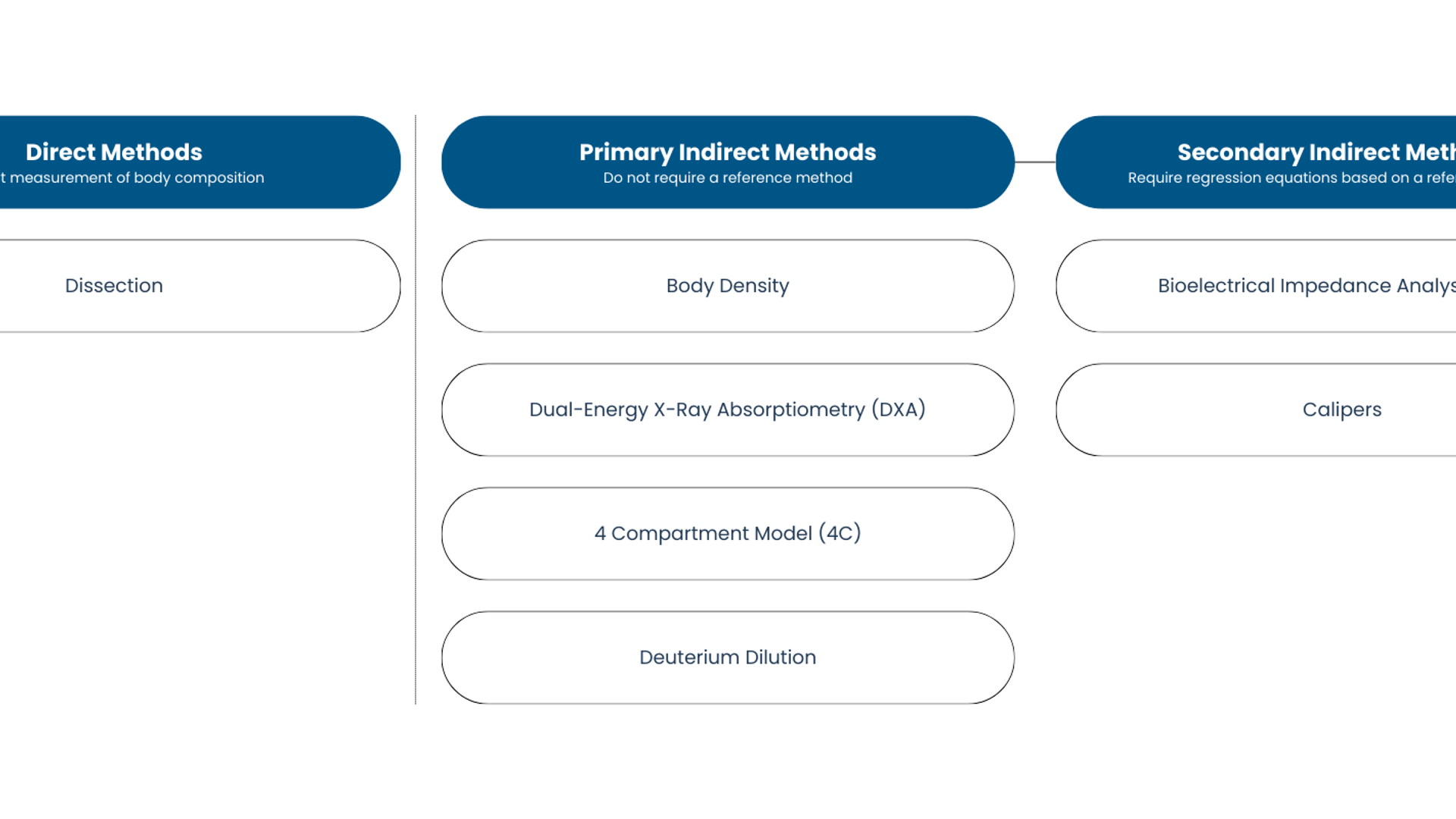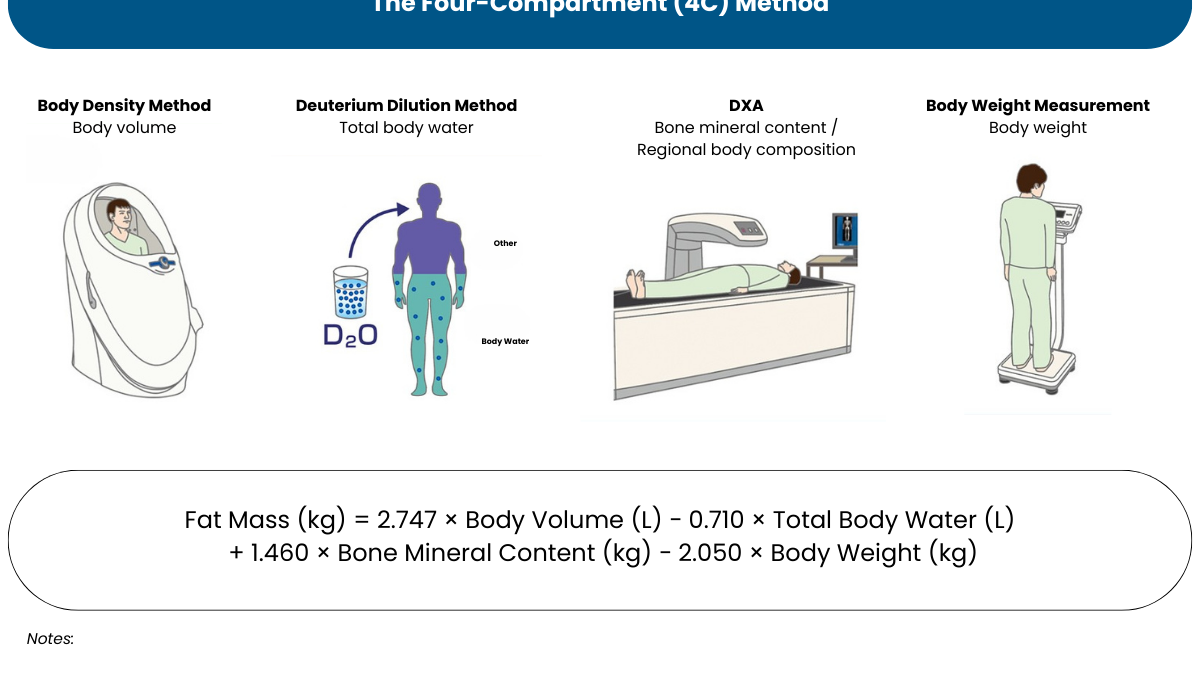
The Four-Compartment (4C) Method: The Most Accurate Approach to Body Composition Evaluation
Body composition is an essential parameter in clinical medicine, sports science, and health management. While numerous methods exist for evaluating body composition, their accuracy varies due to inherent assumptions and methodological limitations. This paper provides a technical overview of the four-compartment (4C) model, which integrates multiple reference techniques and is regarded as the most accurate method currently available. Its strengths, limitations, and relevance for bioelectrical impedance analysis (BIA) algorithm development are discussed.
Note: This article was originally published by TANITA Japan in 2022 and has been translated from its original Japanese.
___
Abstract#
Body composition is an essential parameter in clinical medicine, sports science, and health management. While numerous methods exist for evaluating body composition, their accuracy varies due to inherent assumptions and methodological limitations. This paper provides a technical overview of the four-compartment (4C) model, which integrates multiple reference techniques and is regarded as the most accurate method currently available. Its strengths, limitations, and relevance for bioelectrical impedance analysis (BIA) algorithm development are discussed.
Introduction#
Body composition can be assessed by direct or indirect methods. Direct evaluation requires dissection, and therefore is impractical for living subjects. Consequently, body composition in humans must be estimated by indirect approaches. Indirect methods can be further subdivided into primary indirect methods—derived from theoretical models without reliance on reference equations—and secondary indirect methods, which depend on regression models built from primary techniques.

Primary indirect methods include body density techniques (underwater weighing, air displacement plethysmography), dual-energy X-ray absorptiometry (DXA), and the four-compartment (4C) model. These methods are characterized by high validity and reliability. In contrast, BIA, the basis of most consumer body composition analyzers, is a secondary indirect method requiring regression equations derived from primary reference data.
Limitations of Conventional Primary Methods#
Body Density Techniques#
Body density methods assume constant densities for fat and fat-free tissues and a fixed ratio of components within fat-free mass【1】. These assumptions do not account for inter-individual variability, which can introduce error.
Dual-Energy X-Ray Absorptiometry (DXA)#
DXA is based on the assumption that the X-ray attenuation coefficient of fat-free mass (excluding bone) is constant. However, research indicates variability in intracellular water, extracellular water, and protein ratios within fat-free tissue【2-3】. Populations such as individuals with edema, older adults, and athletes may deviate significantly from these assumptions, leading to reduced accuracy【4】.
The Four-Compartment (4C) Model#
Methodology#
The 4C model combines four independent measurements:
- Body density (underwater weighing or air displacement plethysmography)
- Total body water (measured via deuterium dilution)
- DXA
- Body weight

From these, body composition is partitioned into four compartments: fat, mineral, protein, and water.
Advantages#
Because fat mass is calculated using equations incorporating body volume, total body water, and bone mineral content【6】, the 4C method avoids reliance on problematic assumptions inherent in single-technique models such as body density or DXA. It is therefore considered the most accurate available method【5】.
Limitations#
Despite its superior precision, the 4C method requires substantial time, specialized equipment, and significant financial resources, limiting its applicability in routine clinical or commercial settings.
Implications for BIA Algorithm Development#
BIA algorithms are derived from regression equations linking impedance measures with reference body composition data. The accuracy of BIA depends directly on the quality of the reference method.
If a reference method deviates substantially from true values, BIA predictions will inherit and amplify these errors. Conversely, algorithms based on the most accurate reference method—namely, the 4C model—yield the lowest error relative to true body composition.
Although few companies employ the 4C method due to its costs, TANITA integrates 4C-derived data into BIA development to enhance accuracy, a process referred to as “4C Technology.”
Conclusion#
Primary indirect methods such as the 4C model, body density techniques, and DXA are superior in accuracy compared to secondary methods. However, practical limitations hinder their use in everyday clinical practice.
BIA analyzers have advanced to deliver estimates approaching the accuracy of these methods, while maintaining distinct advantages: simplicity, rapidity, and non-invasiveness. By leveraging 4C data as a reference, BIA algorithm development can minimize deviation from true values and offer both clinical and consumer populations more reliable body composition assessment.
References#
- Roche Af et al. Fundamentals and Applications of Body Composition Research. Taishukan Shoten, 2001.
- Proctor DN et al. Comparison of techniques to estimate total body skeletal muscle mass in people of different age groups. Am J Physiol, 277: E489-95, 1999.
- Silva AM et al. Extracellular water: greater expansion with age in African Americans. J Appl Physiol, 99: 261-7, 2005.
- Roubenoff R et al. Use of dual-energy x-ray absorptiometry in body-composition studies: not yet a “gold standard.” Am J Clin Nutr, 58: 589-91, 1993.
- Baumgartner RN et al. Body composition in elderly people: effect of criterion estimates on predictive equations.Am J Clin Nutr, 53: 1345-53, 1991.
- Fuller NJ et al. Four-component model for the assessment of body composition in humans: comparison with alternative methods, and evaluation of the density and hydration of fat-free mass. Clin Sci (Lond), 82: 687-93, 1992.